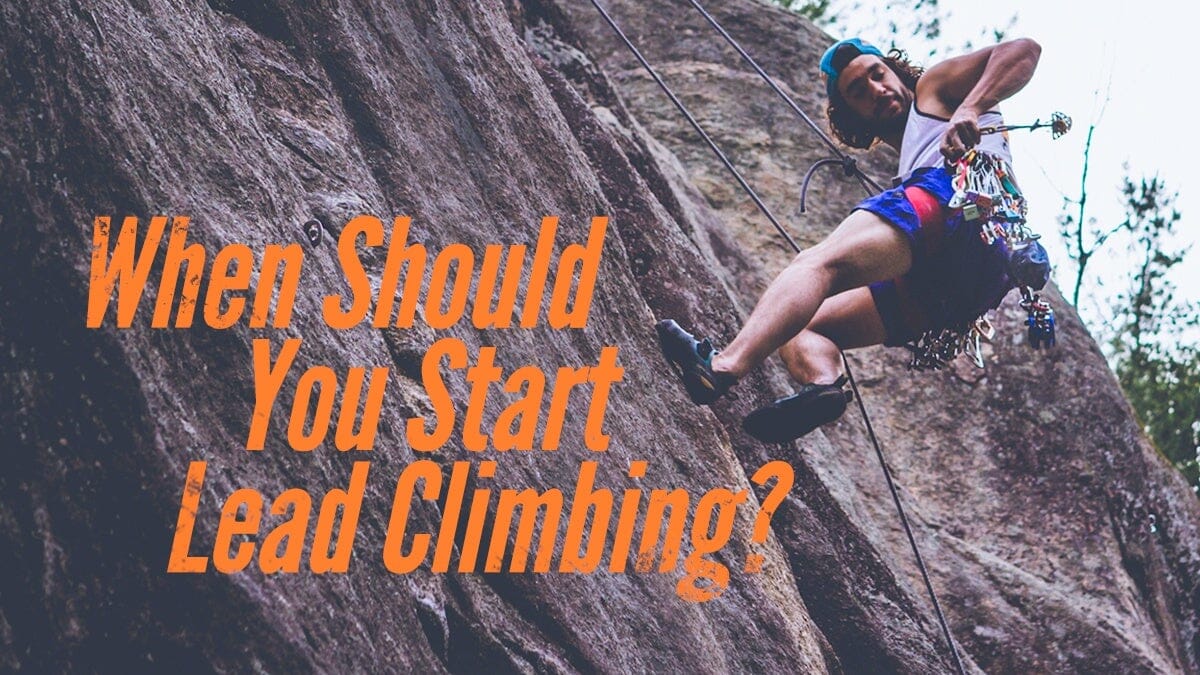When Should You Start Lead Climbing?

Lead climbing is climbing up the rock with your rope directly attached to the belayer. As you climb, you set your own protection or clip quickdraws into bolts. Setting your protection is called Traditional Climbing (or trad climbing), and you’ll need specific pieces to place. The trad gear list includes cams, nuts, quickdraws, carabiners, cordelette, a rope and a nut tool to remove the pieces after your climb.
The other form of lead climbing is called Sport Climbing. This form of climbing has protection set for you in the form of bolts. The gear list for Sport Climbing is much shorter than that of Traditional Climbing. You will need quickdraws, carabiners, and a rope. Depending on your anchors at the top, you may need cordelette as well.
The above gear lists for Traditional and Sport Climbing are referring only to the gear you’ll need for the actual climb. You’ll also need equipment for you and your belayer such as harnesses, helmets and a positive attitude.
Lead climbing requires more skill and focus than top rope climbing. It also needs more from your mental game. The falls taken during lead climbing have the potential to be longer and harder than top rope falls.
There is no magical formula for when you should start lead climbing. However, ask yourself the following questions, and you will better understand when it could be right for you.
1. What grade can you comfortably climb at?
If you can comfortably climb at a 5.9 grade, you are ready to start playing in the lead climbing pool. You should be able to top out on some 5.10s, but if you are projecting 5.10s, that’s okay too. If you are not climbing at a 5.9 yet, keep working on technique. It’s less about the brute strength and more about how to position your body to get up the wall. Experiment with balance, holding the rocks in different ways and observing people that climb differently from you.
2. How is your mental game?
If you are on a top rope climb and 5 feet up in the air just trying to figure out how to breathe, it is not for you yet. You should feel comfortable enough with your gear at this point to trust it. The only way you’ll get more comfortable with heights is to climb and know your gear. If you feel comfortable with top rope climbing and the height factor, you may be ready.
3. Have you practiced indoors?
The culture of climbing is growing at such a fast pace that indoor gyms are popping up all across the United States. The fantastic thing about indoor gyms is that you can train all-year-round. You can also take lead climbing clinics and train indoors where there is a padded floor for nice cloud-like landings.
4. Do you know the crew?
It’s just a fact. Climbing is a social sport. For you to learn how to lead climb, you’re going to need some friends. Ideally, friends that already know how to lead climb. Watching them climb, asking questions and then learning how to clip and climb yourself is a great way to begin.
5. Jump in the currents and swim, baby!
Be honest about where your climbing level is at. If you are comfortably climbing at a 5.9 level (pushing 5.10), trusting your gear and hanging out with other lead climbers that are willing to help you… get out there and start climbing! If you need some inspiration or encouragement, our team is here to help. If you’d like some more dirty deets on climbing, visit our Beta Blog. And finally, make sure you’ve got the correct gear to get out there.
If you are not quite ready for lead climbing, your assignment is simple: keep climbing. You’ll get there one day.




